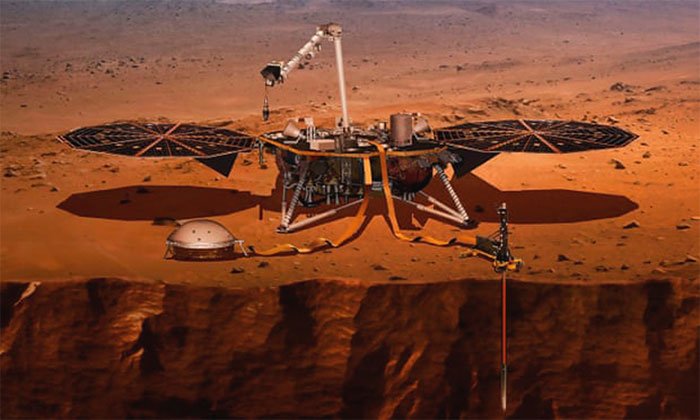NASA spacecraft detected hundreds of Martian earthquakes
Most of the Martian earthquakes recorded by the InSight were relatively mild and located at great depths, about 30-50km.
The first research results are based on the data of the InSight spacecraft published in Nature Geoscience and Nature Communications on February 24. The ship landed on Mars' surface in 2018 and first detected earthquake signals in April 2019.
Many of the earthquakes InSight detected were so small that if they happened on Earth, people probably wouldn't realize, according to Philippe Lognonné, one of the ship's supervisors."We can say the danger from the seismic on Mars is very small, at least for the time being , " Lognonné said.

InSight ships operate on the red planet's surface.(Photo: Guardian).
The 24 largest earthquakes described in the study only reached 3 or 4 degrees. On Earth, they are strong enough for humans to feel but usually do not cause much damage. Unlike the blue planet, where earthquakes appear relatively close to the surface, Martian earthquakes tend to form at much greater depths, around 30-50km. The deeper the earthquake, the less vibration is felt on the surface.
Previously, researchers hoped to discover larger earthquakes, thereby understanding more about the earth, even the core of Mars. However, this has not yet happened.
"The common cause of Mars earthquakes is the planet's long cooling process , " said Bruce Banerdt, research expert InSight mission. The interior of Mars, like the Earth, cools down as the planet forms. As it cools, it shrinks and the outer crust cracks crack, causing the surface to shake. It is a general trend, but the specific cause of each earthquake remains a mystery.
InSight helps scientists record many Martian earthquakes. In the new study, they analyzed data from 174 matches found before September 30, 2019. To date, devices on the InSight have detected about 450 vibrations.Most of these vibrations could be earthquakes , according to NASA.
InSight's mission is expected to extend for nearly another year. During this time, the team on Earth will continue to collect more data about the activities that take place in the heart of Mars.
- NASA launched a probe to study earthquakes on Mars
- NASA released the first recording of an earthquake on Mars
- NASA landing gear gains strange pulses on Mars
- NASA develops dust storm forecasting technology on Mars
- NASA first detected the
- Found freshwater lakes that once existed on Mars
- NASA connected with the spacecraft that had lost its signal two years ago
- Hundreds of houses collapsed due to earthquakes in China
- NASA tested a UFO-like spacecraft
- NASA tested the 'flying saucer' to block heat for the Martian landings
- 'Martian Gardens - Martian Gardens' helps scientists find a way to grow vegetables on Mars
- American aircraft will fly on Mars
- Hundreds of earthquake aftershocks rocked Italy
- Asteroid diameter of 500m spew rocks into space
 Announced 3 houses on the Moon and Mars
Announced 3 houses on the Moon and Mars Science proves: Mars also knows 'deflated'
Science proves: Mars also knows 'deflated' Elon Musk announced the price for a Mars trip was 11.6 billion VND, free of charge
Elon Musk announced the price for a Mars trip was 11.6 billion VND, free of charge NASA discovered strange 'gate' on Mars, is the hiding place found?
NASA discovered strange 'gate' on Mars, is the hiding place found?